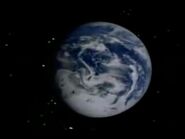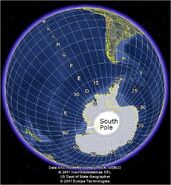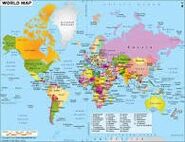| Earth | |
|---|---|

| |
| Number of Sattelites | 2 |
| Atmospheric Makeup | 78% nitrogen, 20.5% oxygen 0.9% argon 0.04% carbon dioxide |
| Distance from Sun | 93 million miles |
| Diameter | 7900 miles 12,756 kilometers |
| Axial tilt | 23.4 degrees |
| Orbit | 365.25 Earthen days |
| Position in Solar System | Third planet from Sun |
| Surface Features | 29.2% land 70.8% water |
| Albedo | (geometric) 0.367 (bond) 0.306 |
| Aphelion | 95.06 million miles |
| Perihelion | 91.936 million miles |
| Mass of Planet | 5.974 x 10^24 kg |
| Escape Velocity | 11.12 kilometers/second |
The Earth is the third planet from the Sun and was the only planet we know of to support life untill 2015, when people discover salt water in Mars. The Earth is the planet we live on, and supports more than seven billion people. Without it, there is no other place we know of to be able to allow us to thrive and survive as we do today.
Formation
The Earth was formed by nebula gases leftover from the formation of the Sun. The gases formed a solid from rotating around in a pattern and compacting together in a process called accretion.
After the gases formed the Earth, the Earth was in a state where numerous meteorites collided with the Earth. This was the state the Earth was in before the cooling process began. This state was called the late heavy bombardment period. This period ended when a Mars-sized object collided with the Earth, causing trillions of tons of Earth to fly into air. Somewhat, this would later create the Moon. Earth then was cooled by celestial particles that floated to the surface.
This then created the Earth we know now.
Sibling Incompatibility
Venus, the Earth's neighboring planet, is classified as its "sister" because of its similar size and shape. They are exact opposites though. Venus is a planet of volcanic activity and the surface are filled with lava. Earth, on the other hand, is 70.6% water and can support life. Venus and Earth are not the best set of siblings as you can see.
Atmospheric Makeup
The Earth's atmosphere is mostly made of nitrogen. In fact, more than three fourths of the atmosphere is nitrogen. Oxygen makes up just more than one-fourth of the atmosphere. The rest is made up of less than one percent argon and carbon dioxide.
The atmosphere is split into two main layers: the troposphere and the stratosphere. The troposphere is the closest layer of the atmosphere to us. All of the weather on Earth occurs in this layer. The stratosphere is the lowest layer of the mesosphere, and is where the temperature of the atmosphere begins to increase due to the absorption of ultraviolet radiation from the Sun. This layer is also rich with ozone, for it contains a portion of the ozone layer.
Other layers include the mesosphere, the region in the atmosphere at which the temperatures drop to below -100 degrees Fahrenheit due to radiation being reflected away from this layer into the stratosphere. This layer is where the majority of the ozone layer is found. The ozone layer is the layer created by the build up of ozone, which is a gaseous substance that absorbs most of the ultraviolet radiation from the Sun.
Clouds are another addition in the atmosphere. These occur when air in the troposphere begins to rise and then fall. The cool air falls since it is more dense and the warm air rises because it is less dense. This process is called convection. When water vapor rises, it becomes heated and continues rising because it becomes less dense. Then, once it rises above the clouds, it cools and condenses, becoming clouds.
Structure
Internal Structure
Tectonic Plates
Tectonic plates are the makeup of the lithosphere. These plates can be 60 km thick and are the plates that drive the continents. These plates can join together to form boundaries. Some boundaries can cause geographical features such as mountains when they collide and push up the crust plate (convergent boundary), some can cause earthquakes when they slide against each other causing tension (transform boundary), or seafloor spreading when two plates move away from one another (divergent boundary).
Due to this, there is a process called continental drift. Continental drift was founded by Alfred Wegener, and involves all of the continents moving about the Earth, but the change is so small, it is undetectable by humans. This theory proves that Pangaea existed more than 300 million years ago. Pangaea was a supercontinent that combined all of the known continents we know today. Through the process of continental drift, Pangaea split up after going through several changes and shifted into the places the continents are in today.
Orbit and Rotation
Earth's orbit takes one Earthern year. This is equal to 365.25 Earthern days. With the extra one-fourth, every four years, the one-fourth becomes a whole and adds an extra Earthern day, making it a leap year.
Earth takes 23 hours, 57 minutes to make one rotation on its axis. This number is mostly rounded to what we know as 24 hours in one Earthen day.
Pictures
| The Planets and Dwarf Planets | |
|---|---|
| Planets | |
| Mercury • Venus • Earth • Mars • Jupiter • Saturn • Uranus • Neptune | |
| Dwarf Planets | |
| Ceres • Pluto • Haumea • Makemake • Quaoar • Eris | |




